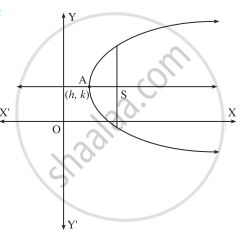Advertisements
Advertisements
Question
Find the differential equation all parabolas having a length of latus rectum 4a and axis is parallel to the axis.
Solution

Let A(h, k) be the vertex of the parabola whose length of the latus rectum is 4a.
Then the equation of the parabola is
(y - k)2 = 4a(x - h), where h and k are arbitrary constants. Differentiating w.r.t. x, we get
`2("y - k") * "d"/"dx" ("y - k") = 4"a" "d"/"dx" ("x - h")`
∴ `2("y - k")("dy"/"dx" - 0) = "4a"(1 - 0)`
∴ `2("y - k")"dy"/"dx" = "4a"`
∴ `("y - k")"dy"/"dx" = "2a"` ...(1)
Differentiating again w.r.t. x, we get
`("y - k") * "d"/"dx" ("dy"/"dx") + "dy"/"dx" * "d"/"dx" ("y - k") = 0`
∴ `("y - k")("d"^2"y")/"dx"^2 + "dy"/"dx" * ("dy"/"dx" - 0) = 0`
∴ `("y - k")("d"^2"y")/"dx"^2 + ("dy"/"dx")^2 = 0`
∴ `"2a"/(("dy"/"dx")) * ("d"^2"y")/"dx"^2 + ("dy"/"dx")^2 = 0` ....[By (1)]
∴ `"2a" ("d"^2"y")/"dx"^2 + ("dy"/"dx")^3 = 0`
This is the required D.E.
APPEARS IN
RELATED QUESTIONS
Obtain the differential equation by eliminating the arbitrary constants from the following equation:
Ax2 + By2 = 1
Obtain the differential equation by eliminating the arbitrary constants from the following equation:
(y - a)2 = 4(x - b)
In the following example verify that the given expression is a solution of the corresponding differential equation:
xy = log y +c; `"dy"/"dx" = "y"^2/(1 - "xy")`
In the following example verify that the given expression is a solution of the corresponding differential equation:
y = `(sin^-1 "x")^2 + "c"; (1 - "x"^2) ("d"^2"y")/"dx"^2 - "x" "dy"/"dx" = 2`
In the following example verify that the given expression is a solution of the corresponding differential equation:
y = `"a" + "b"/"x"; "x" ("d"^2"y")/"dx"^2 + 2 "dy"/"dx" = 0`
In the following example verify that the given expression is a solution of the corresponding differential equation:
y = `"e"^"ax"; "x" "dy"/"dx" = "y" log "y"`
Solve the following differential equation:
`"dy"/"dx" = (1 + "y")^2/(1 + "x")^2`
Solve the following differential equation:
`log ("dy"/"dx") = 2"x" + 3"y"`
Solve the following differential equation:
`"dy"/"dx" = - "k",` where k is a constant.
Solve the following differential equation:
`(cos^2y)/x dy + (cos^2x)/y dx` = 0
Solve the following differential equation:
`2"e"^("x + 2y") "dx" - 3"dy" = 0`
For the following differential equation find the particular solution satisfying the given condition:
`("x" + 1) "dy"/"dx" - 1 = 2"e"^-"y" , "y" = 0`, when x = 1
Reduce the following differential equation to the variable separable form and hence solve:
`"x + y""dy"/"dx" = sec("x"^2 + "y"^2)`
Solve the following differential equation:
(x2 + y2)dx - 2xy dy = 0
Choose the correct option from the given alternatives:
The differential equation of y = `"c"^2 + "c"/"x"` is
Choose the correct option from the given alternatives:
x2 + y2 = a2 is a solution of
Choose the correct option from the given alternatives:
The solution of `"dy"/"dx" = ("y" + sqrt("x"^2 - "y"^2))/"x"` is
The integrating factor of linear differential equation `x dy/dx + 2y = x^2 log x` is ______.
Choose the correct option from the given alternatives:
The solution of the differential equation `"dy"/"dx" = sec "x" - "y" tan "x"`
Obtain the differential equation by eliminating the arbitrary constants from the following equation:
`"y"^2 = "a"("b - x")("b + x")`
Obtain the differential equation by eliminating the arbitrary constants from the following equation:
y = `sqrt("a" cos (log "x") + "b" sin (log "x"))`
Solve the following differential equation:
`"dy"/"dx" + "y cot x" = "x"^2 "cot x" + "2x"`
Find the particular solution of the following differential equation:
`"dy"/"dx" - 3"y" cot "x" = sin "2x"`, when `"y"(pi/2) = 2`
Find the particular solution of the following differential equation:
(x + y)dy + (x - y)dx = 0; when x = 1 = y
The differential equation having y = (cos-1 x)2 + P (sin-1 x) + Q as its general solution, where P and Q are arbitrary constants, is
Find the differential equation of the family of all non-horizontal lines in a plane
Find the differential equation of the family of parabolas with vertex at (0, –1) and having axis along the y-axis
Find the differential equations of the family of all the ellipses having foci on the y-axis and centre at the origin
Find the differential equation of the curve represented by xy = aex + be–x + x2
If m and n are respectively the order and degree of the differential equation of the family of parabolas with focus at the origin and X-axis as its axis, then mn - m + n = ______.
The differential equation for all the straight lines which are at the distance of 2 units from the origin is ______.
Solve the differential equation
cos2(x – 2y) = `1 - 2dy/dx`
If 2x = `y^(1/m) + y^(-1/m)`, then show that `(x^2 - 1) (dy/dx)^2` = m2y2
Form the differential equation whose general solution is y = a cos 2x + b sin 2x.
Solve the differential equation
ex tan y dx + (1 + ex) sec2 y dy = 0
A particle is moving along the X-axis. Its acceleration at time t is proportional to its velocity at that time. Find the differential equation of the motion of the particle.
